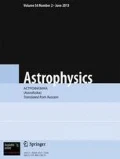We present the first photometric observations and light curve modelling of the discovered systems GSC 01870-00458 and USNO-A2.0-0975 04721840. Our modelling was carried out using a recent Windows interface version of Wilson and Devinney code based on model atmospheres provided by Kurucz. The accepted models revealed absolute and physical parameters that can be used to study the evolutionary states of systems. The parameters show that primary component is more massive and hotter than the secondary component for both systems, and spectral types of the system components were adopted. Locations of both systems on theoretical mass-luminosity and mass-radius curves revealed a good fit for components of both systems except for the secondary component of the system GSC 01870-00458.
Similar content being viewed by others
Change history
30 September 2021
A Correction to this paper has been published: https://doi.org/10.1007/s10511-021-09699-8
References
J. Kallrath and E. Milion, in Eclipsing Binary Stars Modelling and Analysis, New York Springer, 1999.
M. Yilmaz, R. Nelson, H. Senavci et al., RMxAA, 53, 29, 2017.
Q. Liu and Y. Yang, Astron. Astrophys. Suppl., 142, 31, 2000.
K. Nakajima and K. Nagai, Inf. Bull. Var. Stars, 5700, 2006.
A. Liakos and P. Niachros, Inf. Bull. Var. Stars, 5998, 2011.
R. Nelson, http://members.shaw.ca/bob.nelson/software1.htm, 2009.
R. Kurucz, In: E. Milon (Ed.), Light Curve Modeling of Eclipsing Binary Stars. Springer-Verlag, New York, p. 93, 1993.
M. Pecaut, E. Mamaek, Astrophys. J. Suppl. Ser., 208, 9, 2013.
L. Lucy, Z. Astrophys., 65, 89, 1967.
S. Rucinski, Acta Astronaut., 19, 156, 1969.
W. van Hamme, Astron. J., 106, 2096, 1993.
D. Popper, Ann. Rev. Astron. Astrophys., 18, 115, 1980.
P. Harmanec, Bull. Astron. Inst. Czechosl., 39, 329, 1988.
D. Bradstreet and D. Steelman, Astron. Astrophys. Suppl., 201, 7502, 2002.
L. Girardi, A. Bressan, G. Bertelli et al., Astron. Astrophys. Suppl., 141, 371, 2000.
L. Lucy, Astrophys. Sp. Sci., 22, 381, 1973.
S. Ekstrom, C. Georgy, P. Eggenberger et al., Astron. Astrophys., 537, 146, 2012.
O. Y. Malkov, Mon. Not. Roy. Astron. Soc., 382, 1073, 2007.
Author information
Authors and Affiliations
Corresponding author
Additional information
Published in Astrofizika, Vol. 64, No. 1, pp. 41-52 (February, 2021).
Rights and permissions
About this article
Cite this article
Aleanzi, M.S., Elkateeb, M.M. Light Curve Analysis of some Eclipsing Binary Systems. Astrophysics 64, 33–40 (2021). https://doi.org/10.1007/s10511-021-09665-4
Received:
Published:
Issue Date:
DOI: https://doi.org/10.1007/s10511-021-09665-4



